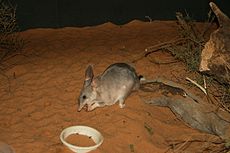Bilby
The bilby (also known as the rabbit-eared bandicoot) is a rabbit-like marsupial. It lives in deserts, dry forests, dry grasslands, and dry shrubby areas in Australia. The bilby's pouch faces backwards. These big-eared, burrowing mammals were in danger of extinction, but now they are back living in New South Wales.[1]
| Bilbies | |
|---|---|

| |
| Scientific classification | |
| Kingdom: | |
| Phylum: | |
| Class: | |
| Infraclass: | |
| Order: | |
| Family: | Thylacomyidae Bensley, 1903
|
| Genus: | Macrotis Reid, 1837
|
| Species | |
The bilby, like all bandicoots, is a nocturnal animal (most active at night). Digging with its strong, clawed feet, this solitary mammal excavates long, complex burrows. Its underground dens are up to 5 feet (1.5 m) long.
Bilbies have the usual long bandicoot muzzle and big ears. They are about 29–55 cm (11–22 in) long. Compared to bandicoots, they have a longer tail, bigger ears, and softer, silky fur. The size of their ears allows them to have better hearing, and to radiate heat.[2][3] They are nocturnal omnivores that do not need to drink water. They get their moisture from food, which includes insects and their larvae, seeds, spiders, bulbs, fruit, fungi, and very small animals. Most food is found by digging or scratching in the soil, and by using their very long tongues.
References
change- ↑ Bilbies back in New South Wales. [1]
- ↑ "Greater bilby". Department of Environment and Science - Queensland Government. 2003-08-08. Archived from the original on 2019-04-23. Retrieved 2019-04-23.
- ↑ "Bilby - Australia's Easter bunny". Environmental Protection Agency/Queensland Park and Wildlife Service. 24 November 2005. Archived from the original on 2006-03-23. Retrieved 2019-04-23.